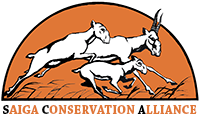*Saiga horns are also known as ling yang (羚羊) and used in Traditional Chinese Medicine
A quarter of all antelope species are threatened with extinction, according to the IUCN Red List of Threatened Species™.
The results, compiled by the Antelope Specialist Group of IUCN’s Species Survival Commission, show that out of 91 species of antelope, 25 are threatened with extinction. The status of several species has become worse since the last complete assessment of all antelopes in 1996.
This includes the saiga antelope, as both S.t.tatarica and S.t.mongolica are listed as declining in number. Whilst S.t.tatarica (found across Russia, Kazakhstan and Uzbekistan) is listed as critically endangered due to a decline of over 80% in the last 10 years, the Mongolian subspecies is listed as Endangered, due to a decline of over 50% during the same period. The species overall remains listed as Critically Endangered, representing an extremely high risk of extinction in the wild.
“Unsustainable harvesting, whether for food or traditional medicine, and human encroachment on their habitat are the main threats facing antelopes,” says Dr Philippe Chardonnet, Co-Chair of the IUCN Antelope Specialist Group. “Most antelopes are found in developing countries which is why it’s critically important that we collaborate with local communities there since it is in their own interest to help preserve these animals.”
Five species of antelope are in the highest category of threat, Critically Endangered, including the Dama Gazelle (Nanger dama), Aders’ Duiker (Cephalophus adersi), the Saiga Antelope (Saiga tatarica), Hirola (Beatragus hunteri) and Addax (Addax nasomaculatus). The Scimitar Horned Oryx (Oryx dammah) is already Extinct in the Wild, but there are ongoing efforts to reintroduce it. The Dama Gazelle and Addax are both reduced to tiny remnant populations and highlight the dire situation for wildlife in the Sahelo-Saharan region.
A further nine species are in the next category of threat, Endangered, and another nine are classified as Vulnerable on the IUCN Red List of Threatened Species.
Nearly 70 percent of antelope species are not threatened with extinction and some areas of the world are doing better than others in terms of antelope populations. India, for example, is home to four species of antelope and only one of them is currently regarded as threatened.
“Despite the pressure of living alongside 1.2 billion people, antelopes are doing well in India,” says Dr David Mallon, Co-Chair of the IUCN Antelope Specialist Group. “It is no coincidence that there is very little tradition of hunting in India and gun ownership is rare.”
Overall, populations are stable in 31 percent of antelope species and decreasing in 62 percent of antelope species. The Springbok (Antidorcas marsupialis) a native of southern Africa is the only antelope species with a long-term increasing trend, mainly as a result of the game ranching industry.
Read this article on the IUCN website or download a copy of the antelope report.
